How schools have changed over the last 80 years
Talia Lakritz

- US schools in the 1940s looked very different than they do today.
- Chalkboards became Smart Boards, and notebooks have been replaced with laptops.
1942: Students participated in mock air raids.
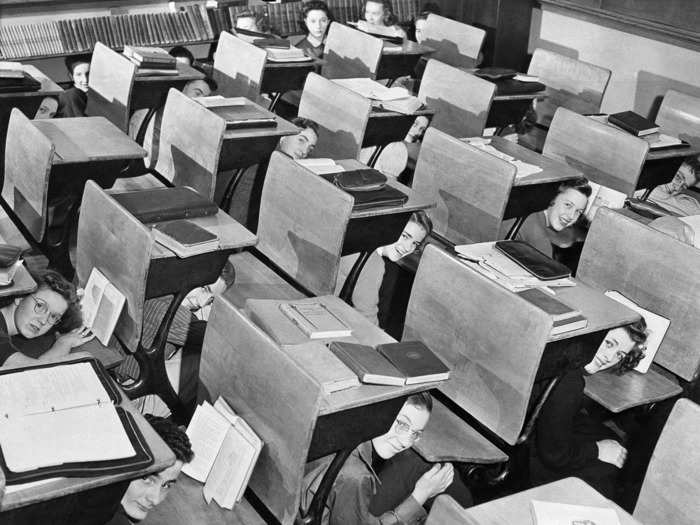
Students in a Seattle, Washington, high school ducked for shelter beneath their desks during a mock air raid in 1942.
1944: A student named Dan Moss presented the news of D-Day to a classroom of younger students.
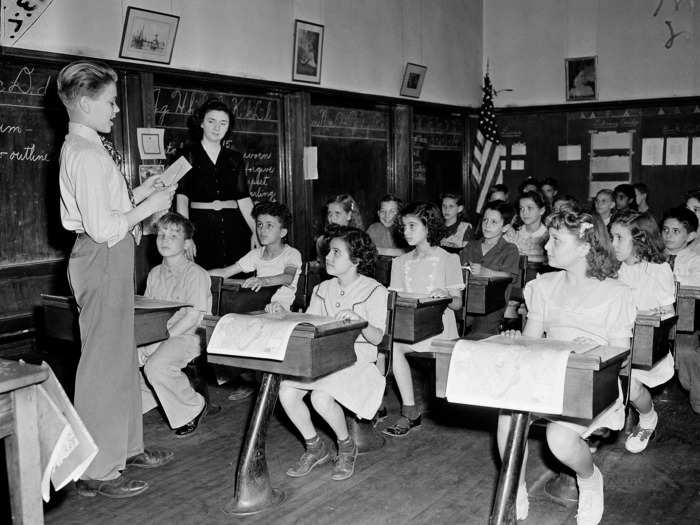
On D-Day, older students at a school in Chicago, Illinois, heard broadcasts, rewrote them for primary students, and reported to classrooms throughout the school.
1947: Road signs in driver's ed looked different back then.
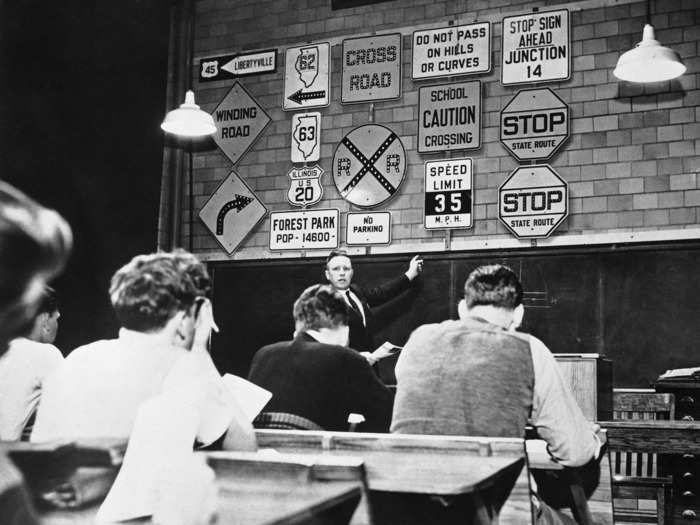
A driving class at Chicago's Lane Technical High School learned the meaning of highway signs and signals in 1947.
1950: Students listened to a radio broadcast.
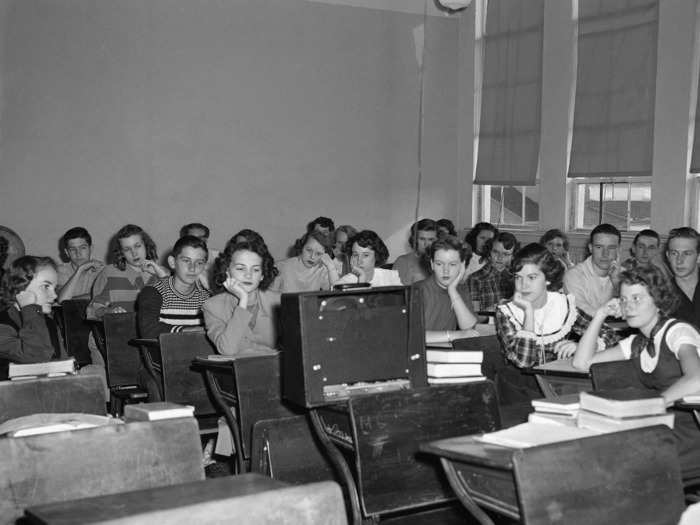
A class at Russell High school in Atlanta, Georgia, listened to a radio broadcast coming from the Atlanta School system's own radio broadcasting station in 1950.
1951: A teacher shows students media and time management.
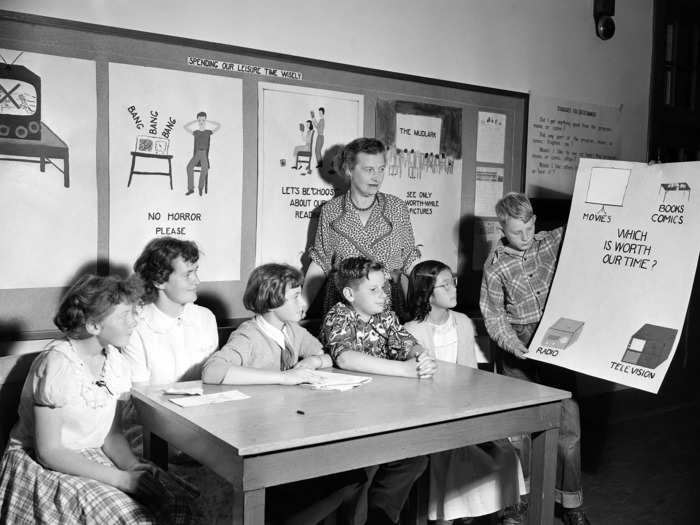
The principal of Lafayette Grammar School in San Francisco, taught students how to choose about which comics, radio programs, TV shows, and movies they spend their time consuming in 1951.
1954: Schools began to integrate after the Supreme Court ruled that segregation was unconstitutional.
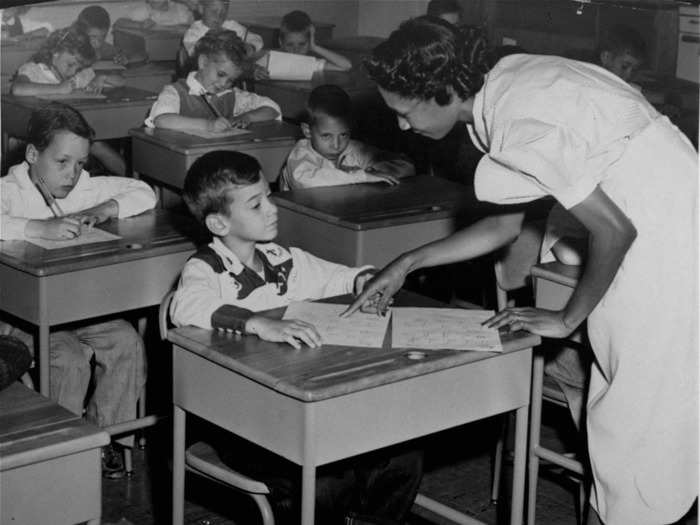
This 1954 photo was taken on the first day of non-segregated schools for teachers and pupils in the District of Columbia public school system. Ella J. Rice was the only Black teacher in the school.
1955: An integrated classroom in Kentucky posed for a photo.
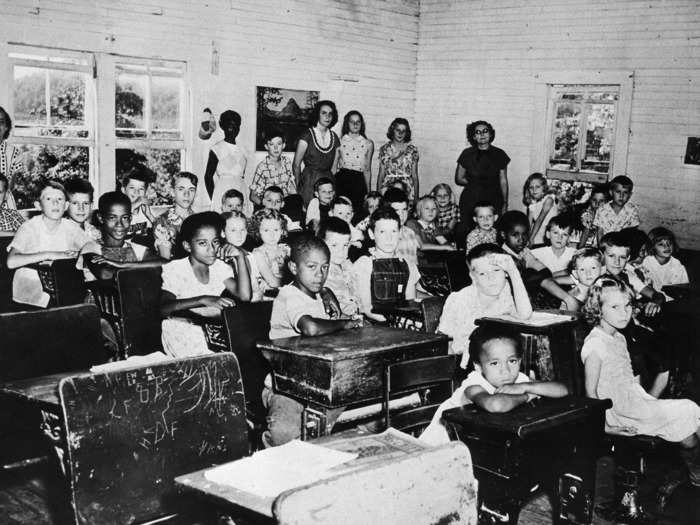
Six Black children completed their first week at Griffin School in 1955, the first Kentucky public school to attempt integration.
1956: Black students at Clinton High School in Tennessee sat at the back of the classroom.
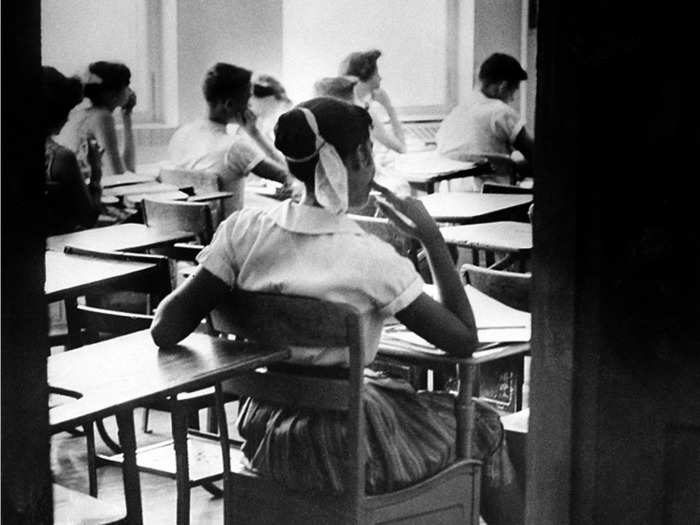
A Black student sat inside a classroom at the newly integrated school in Clinton, Tennessee, in 1956. There were only 12 Black students attending the school at the time, which had been the scene of minor violence as a result of integration, according to AP.
1957: Arkansas National Guardsmen stood guard at Little Rock's Central High School to prevent violence over attendance at the school by nine Black students.
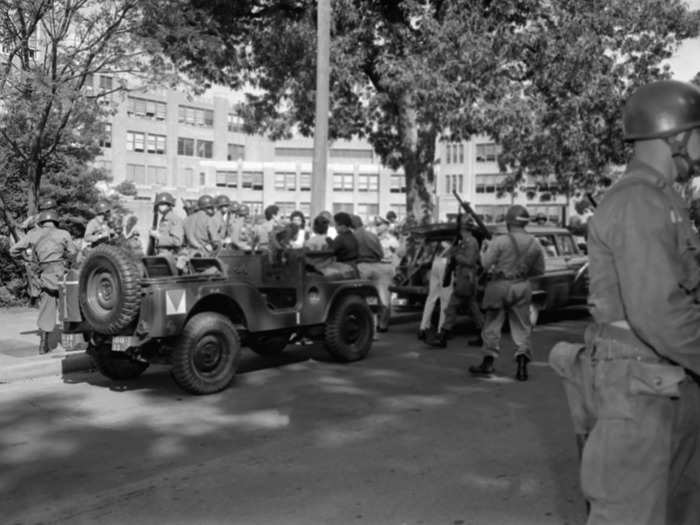
The students became known as the "Little Rock Nine."
1958: Virginia public schools closed to protest integration, forcing students to learn in improvised classrooms.
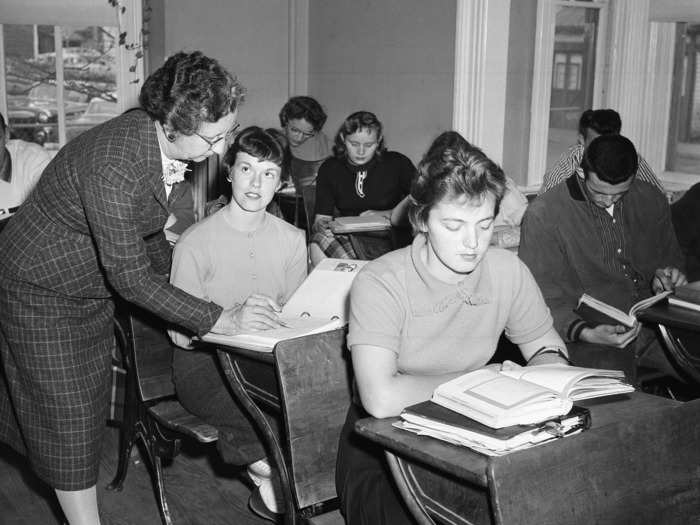
Gaylord Gibson taught language arts to high school seniors in Front Royal, Virginia, in an improvised classroom located in an old youth center building.
1959: Tensions around integration continued.
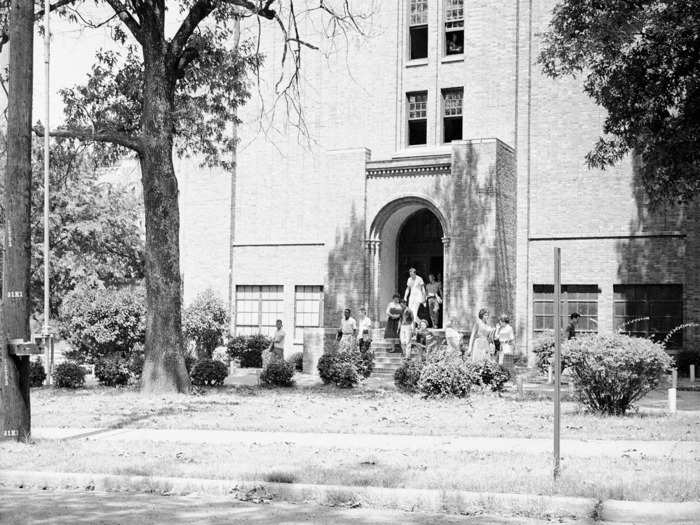
Jefferson Thomas, the only Black student in Central High School, spoke with a white student as they left the school with other pupils. Thomas said it is the first time a student chatted with him in such a friendly manner outside the classroom in Little Rock, Arkansas, in 1959.
1960: Schoolchildren in Manhattan saluted the flag.
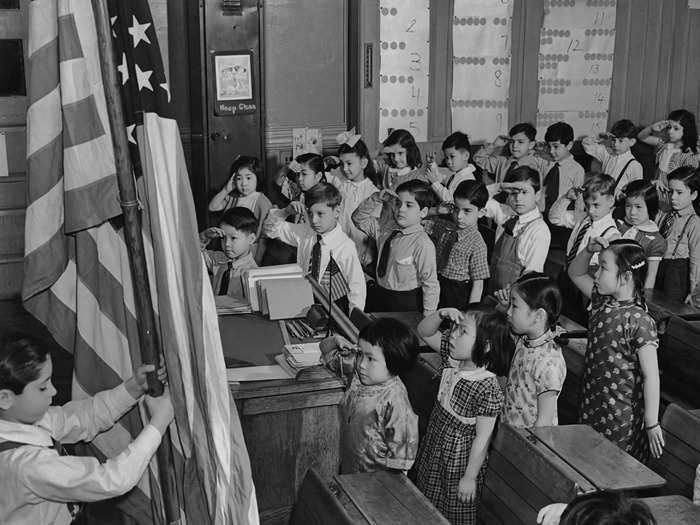
A group of children saluted the American flag at a school in the Chinatown area of Manhattan, New York, in 1960.
1961: One-room schoolhouses were still in use in some parts of the US.
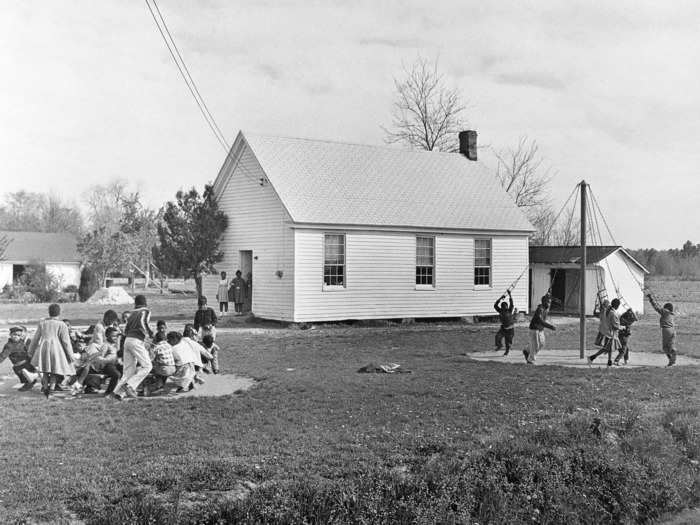
Children played outside of the one-room school house at Madison, Maryland, in 1961. There was an assembly room in addition to the single classroom.
1963: After public schools in Virginia's Prince Edward County remained closed, the Prince Edward Free School Association provided schooling to Black students.
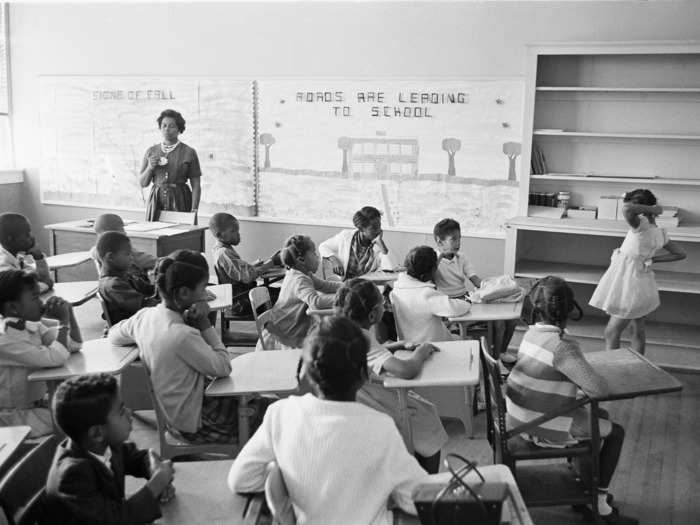
White students in Prince Edward County moved to newly-established private schools when the public schools remained closed rather than integrate, leaving Black students without schooling. The Prince Edward Free School Association filled that gap by leasing the closed public school buildings and starting schools of their own such as the Mary E. Branch number one school in Farmville, Virginia, in 1963.
1964: First graders sat around a table in Chicago.
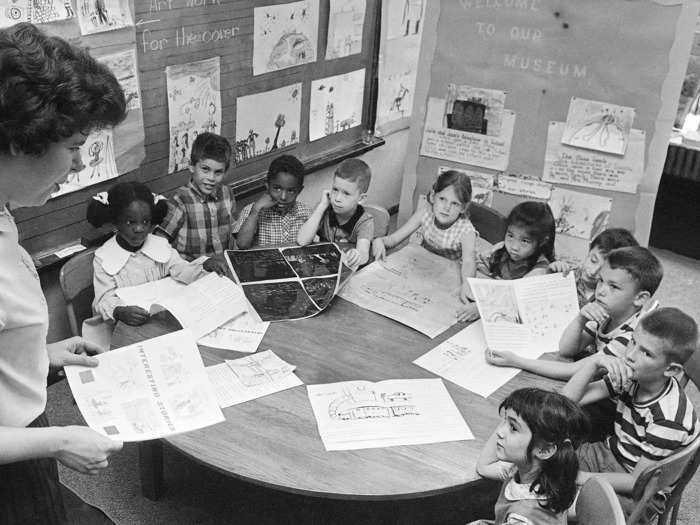
The first graders were students at the University of Chicago Laboratory Schools in Chicago, Illinois.
1968: Children read books in a school library in Queens, New York.
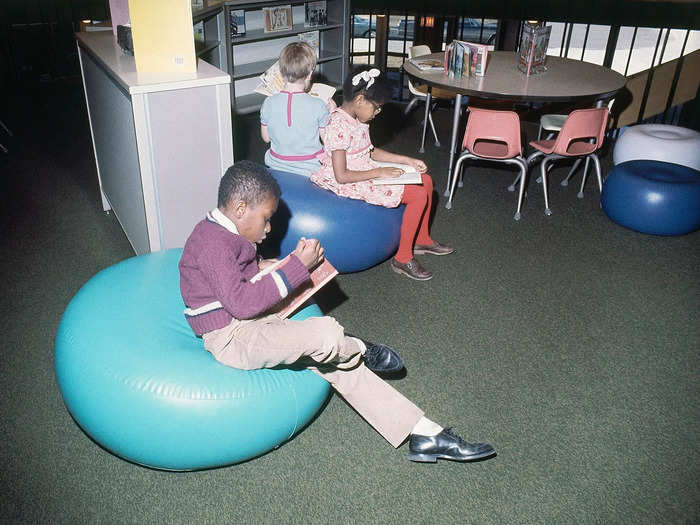
Readers could choose between chairs and exercise balls at PS 219 in Queens, New York, in 1968.
1969: Students learned grammar.
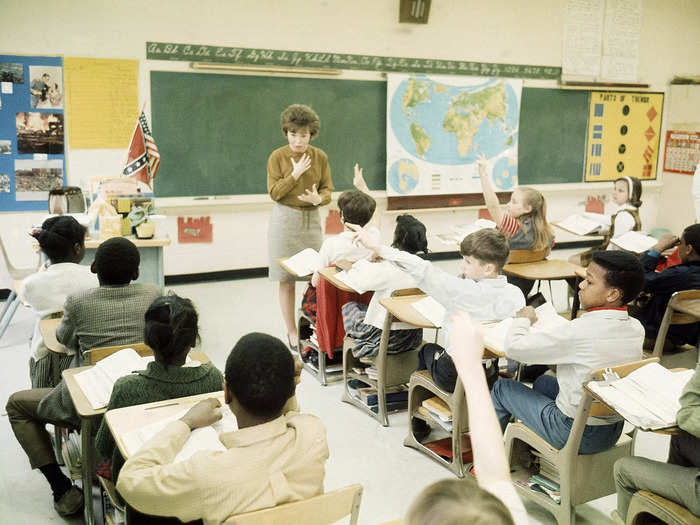
A Confederate flag was displayed in the classroom.
1970: Children played in a Montessori classroom.
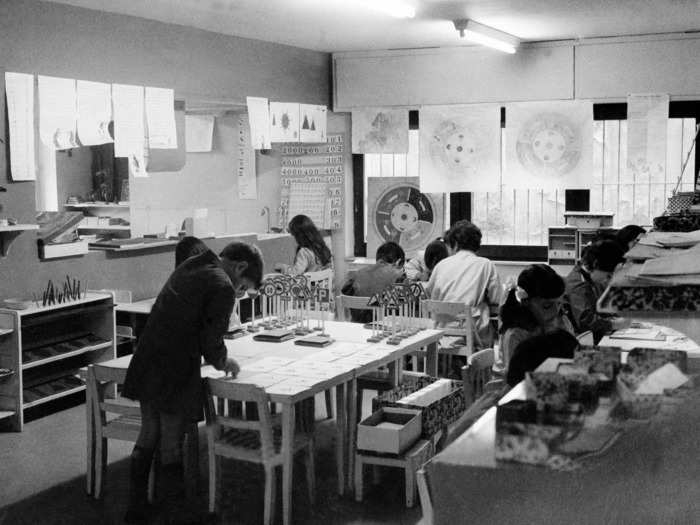
Maria Tecla Artemisia Montessori was an Italian physician and teacher best known for founding the Montessori method of education, a child-centered educational approach that has since gained a global following.
1971: Students boarded a yellow bus after a day at school.
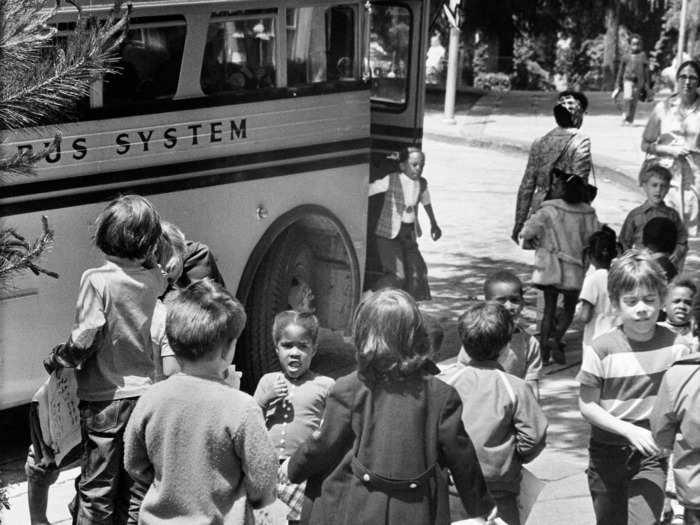
Youngsters from Hillside Elementary school milled around a school bus as the day's classes ended in Berkeley, California, in 1971.
1972: Seventh graders in Brooklyn learned French.
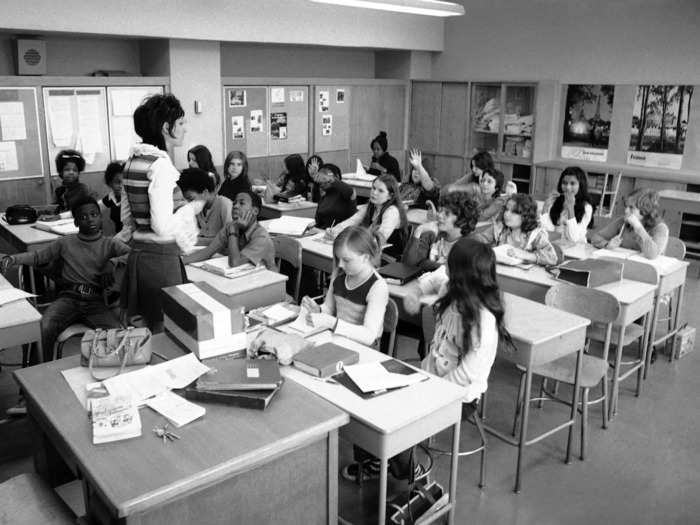
Children got instructions from teacher Barbara Friend during seventh grade French class at Junior High School 211 in the Canarsie section of Brooklyn, New York, in 1972.
1973: Gifted children at President Avenue Elementary School in Los Angeles, California, worked with small computers, rabbit skeletons, and microscopes.
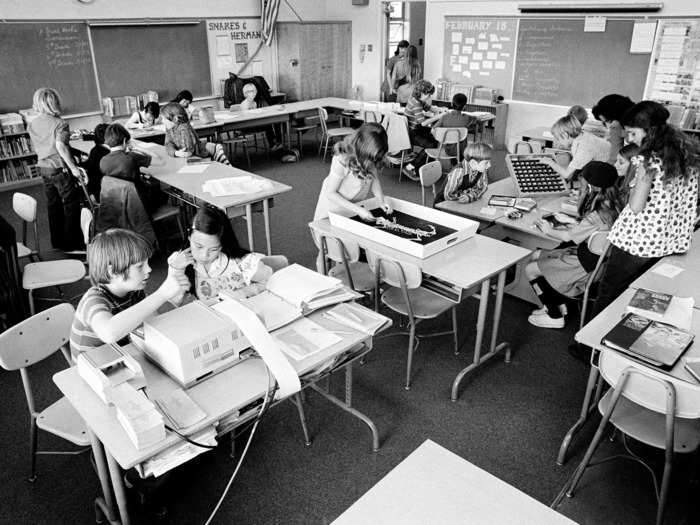
California was one of 10 states that had full-fledged education programs for the gifted in 1973.
1974: Valerie Banks was the only student to show up for her geography class at South Boston High School on the first day of court-ordered busing to desegregate Boston's schools.
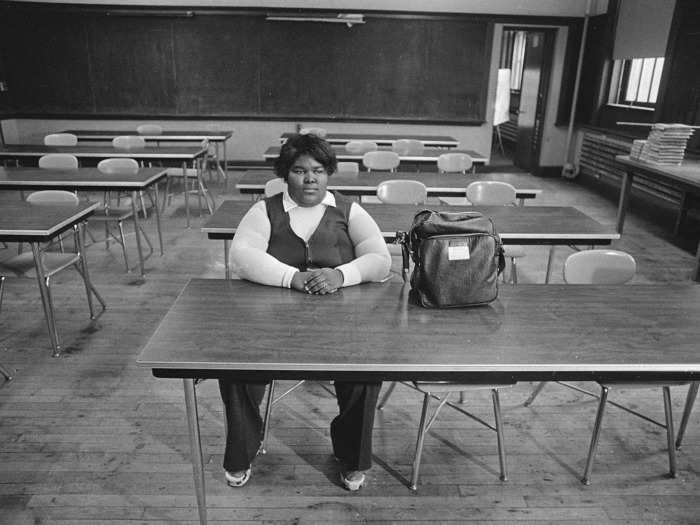
The US District Court in Massachusetts ruled that Boston's public schools were required to integrate via busing in 1974.
1975: A student at Atlantic County Vocational School in Atlantic City, New Jersey, got married during class.
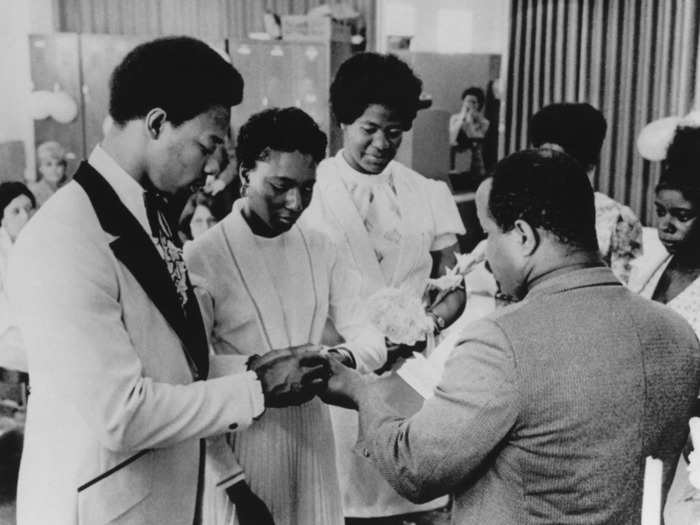
Gary E. Butler, left, exchanged rings with his bride, Christine N. McDuffie, during their wedding in an Atlantic County Vocational School classroom in 1975. The bride was a student there and didn't want to miss a day of training.
1976: Ballerinas struck a pose at The School of American Ballet in New York City.
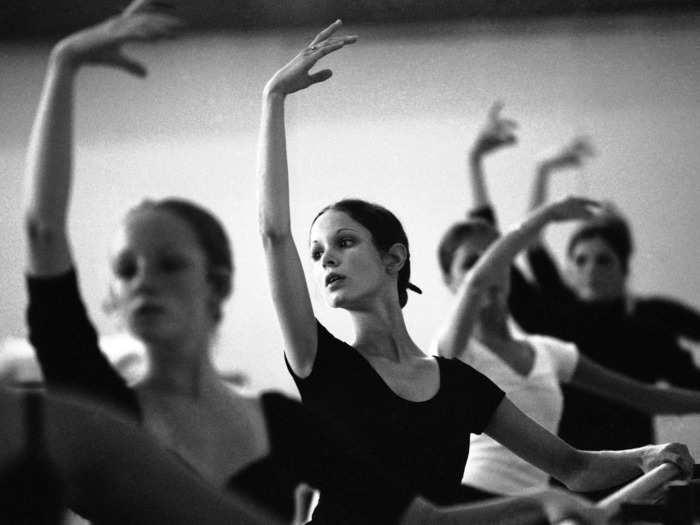
The Association of American Dance Companies listed 350 members in 1976, though not all of professional caliber, compared to 132 in 1966.
1980: Massachusetts law required teachers to ask the students if anyone would like to offer prayer for the class.
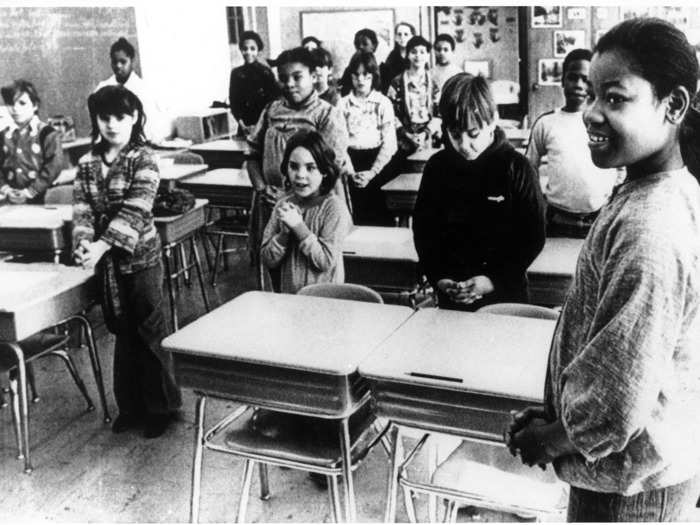
Terri Thompson, 11, led her fourth grade class in a short prayer at the start of the day in a public school in the Dorchester section of Boston in 1980. Any student who did not wish to participate could leave the classroom.
1981: A teacher calls on students in Santa Rosa, California.
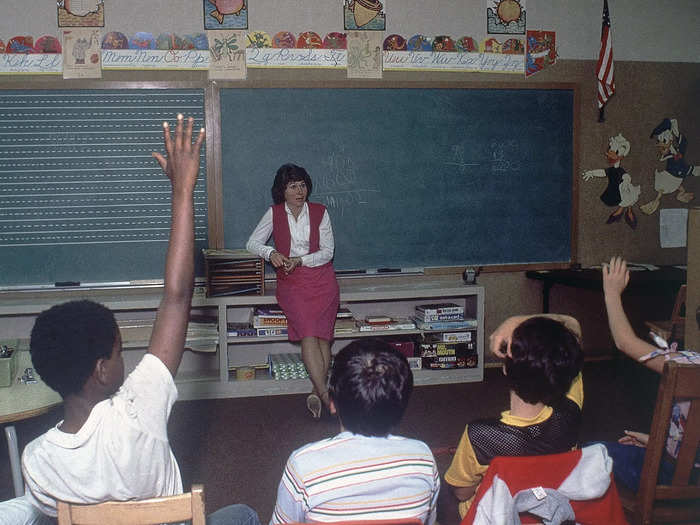
The classroom was decorated with images of Donald and Daisy Duck.
1982: San Jose High School turned a classroom into an arcade as a fundraiser.
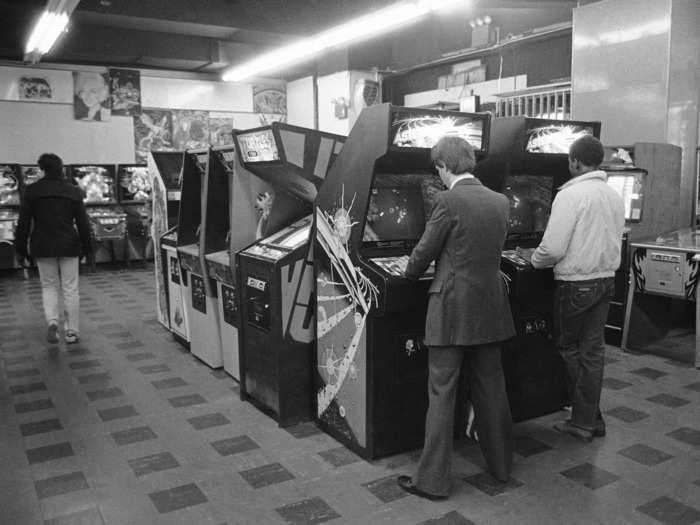
The video arcade games were placed in the high school as an experiment to raise money and produced about $200 in three weeks, according to AP.
1984: Democratic presidential contender Gary Hart talked to a pupil at the Garden Day Care Center Nursery School in New York.
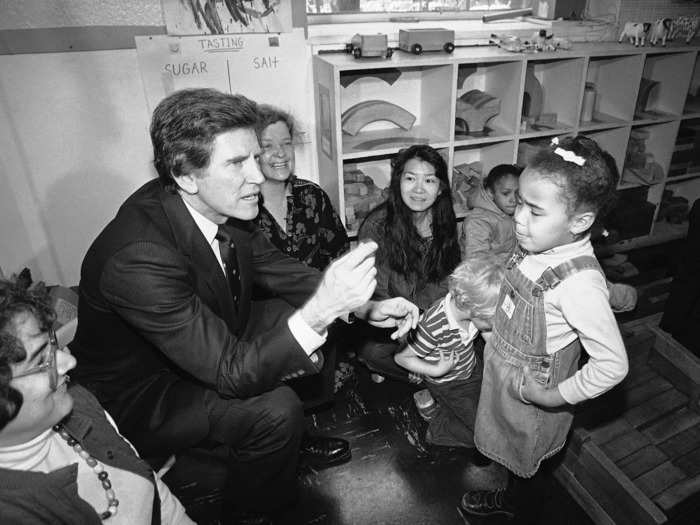
Hart made a campaign stop at the nursery school on the day of the New York presidential primary election.
1985: Rock musician Sammy Hagar stopped by the New School in New York City.
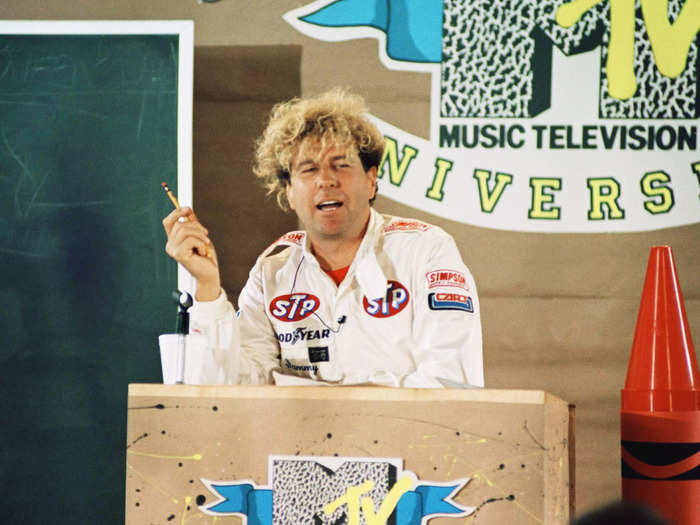
Hagar taught a driving course to a group of MTV contestants.
1986: Fifth graders of the John Swett Alternative School in San Francisco, California, sang for Philippine President Cory Aquino.
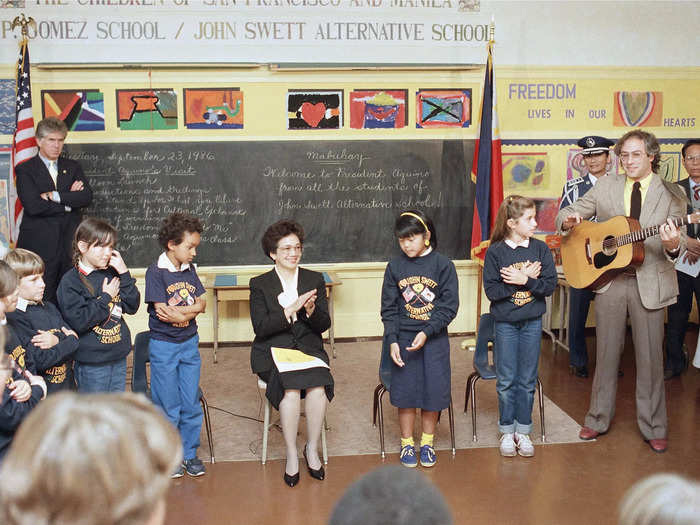
Aquino talked to the children about freedom during her trip to the United States.
1987: Project D.A.R.E. (Drug Abuse Resistance Education) became a staple in schools.
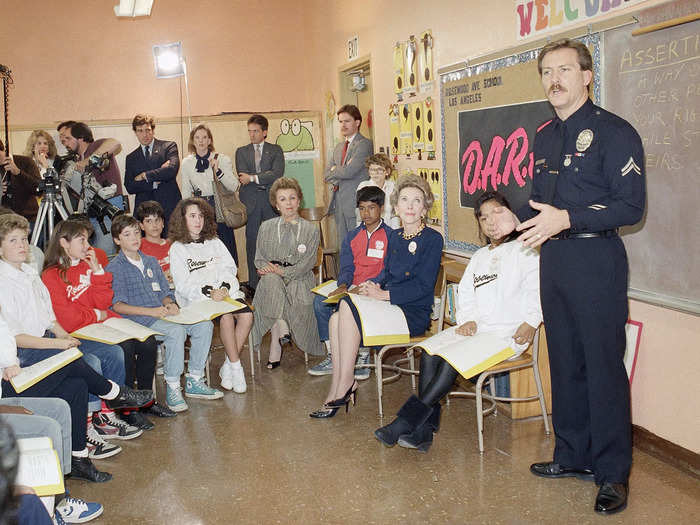
Rosewood Elementary School students in Los Angeles, California, listened to a presentation by police officer Greg Boles in 1987. The presentation was part of Los Angeles police department's Project D.A.R.E., which launched in 1983.
1988: Second graders from P.S. 27 in New York City pet a salamander at the Bronx Zoo.
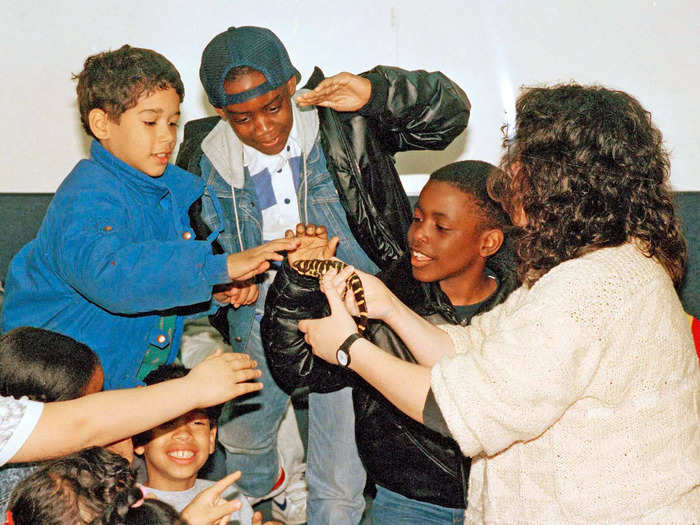
New York City elementary schoolchildren got a few hours to experience science the way scientists do: by touching, observing and experimenting.
1989: Students started learning how to use computers.
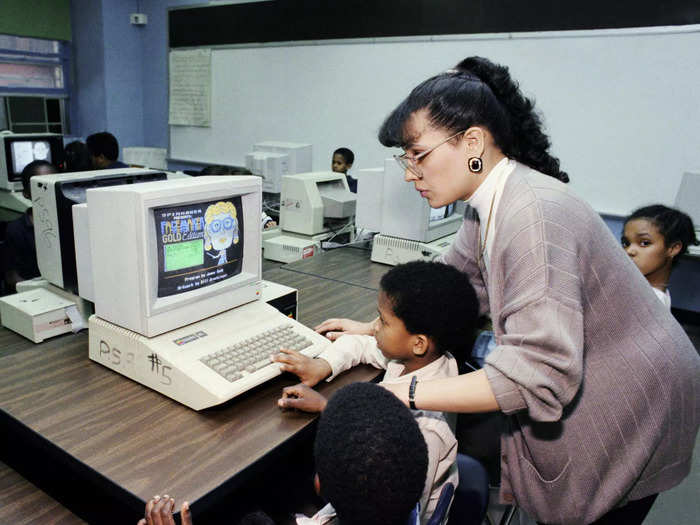
Alicia Custodio, a volunteer for Upward Fund, an organization that runs after school programs in East Harlem, New York, helped two children with the use of a computer.
1990: Students learned to read at the Saturday School program at Coppin State College in Baltimore, Maryland.
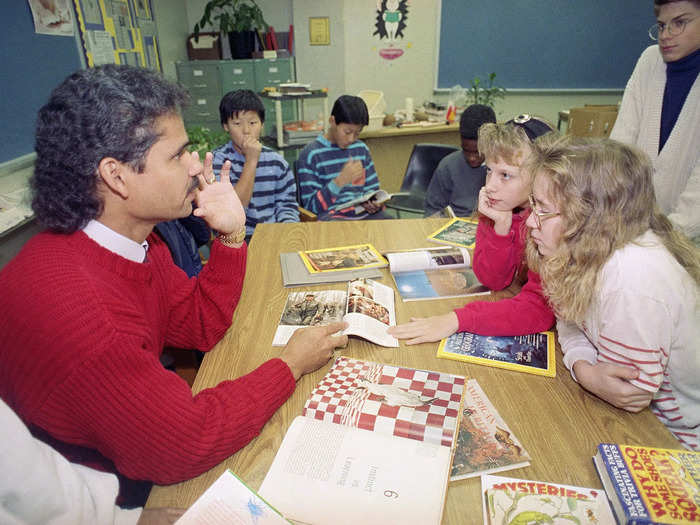
Instructor Tom Payne spoke to students in his "Weird Facts" reading class.
1991: Students discussed current events such as the US war efforts in the Persian Gulf.
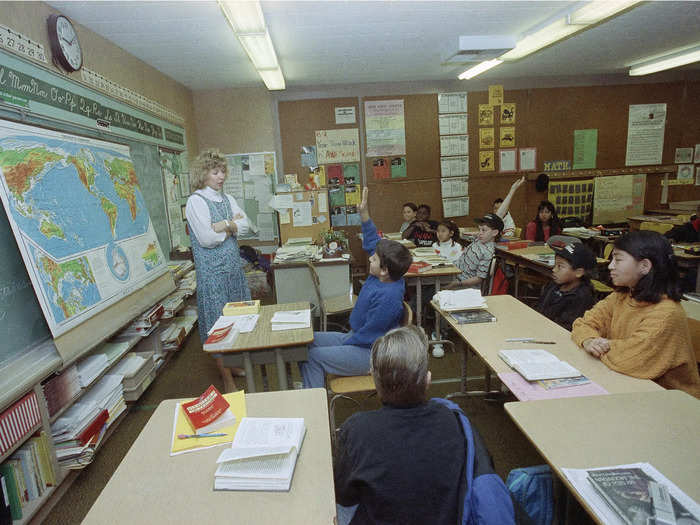
Sixth grade teacher Peggy Reilly and her class had a spirited discussion at Walker Elementary School in San Diego, California.
1992: Hillary Rodham Clinton read books to schoolchildren while campaigning for Bill Clinton's nomination.
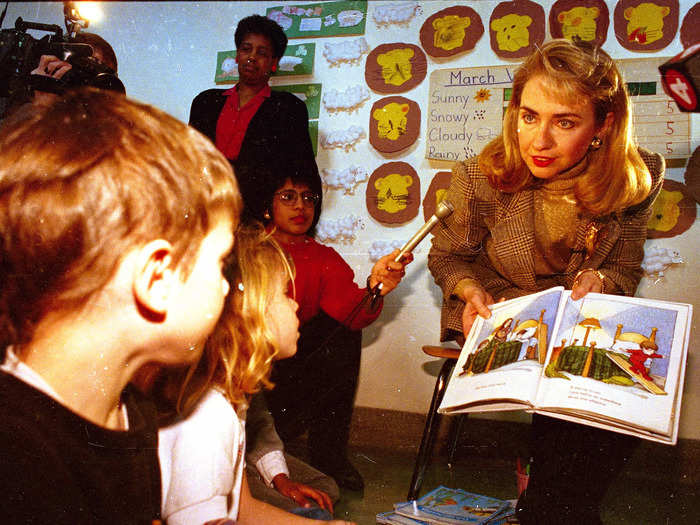
Clinton read "There's An Alligator Under My Bed" to Delois Cunningham's kindergarten class at Public School 31 in Buffalo, New York.
1993: Fourth graders attended an in-class counseling session at Naranja Elementary School in Florida after Hurricane Andrew.
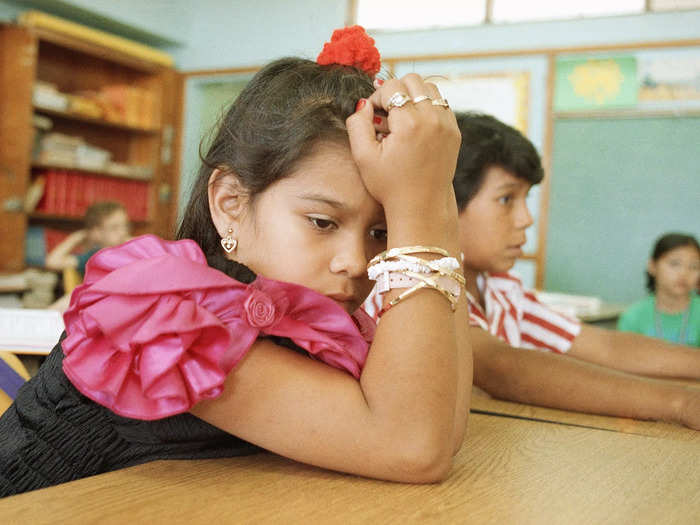
Counselors helped students deal with stress caused by the destruction of their homes by Hurricane Andrew.
1994: Melville High School teacher Rodney Wilson made headlines when he came out as gay.
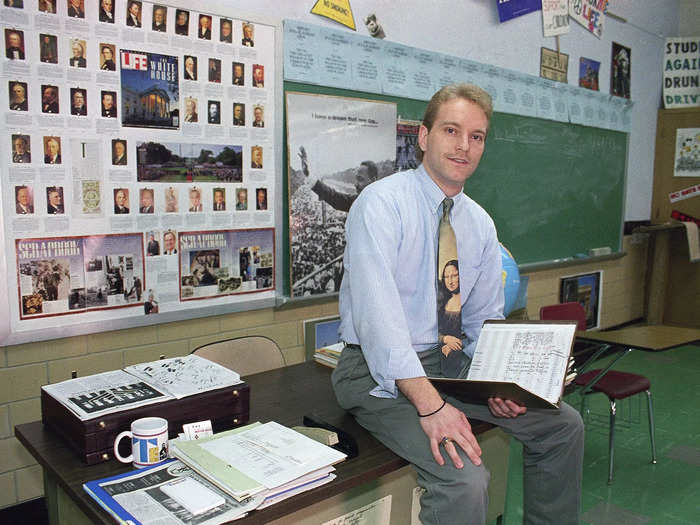
Wilson, a high school history teacher in Missouri, was among a growing number of teachers across the country who chose to discuss their sexual orientation in class.
1995: Classrooms at a Pennsylvania elementary school included children with and without disabilities.
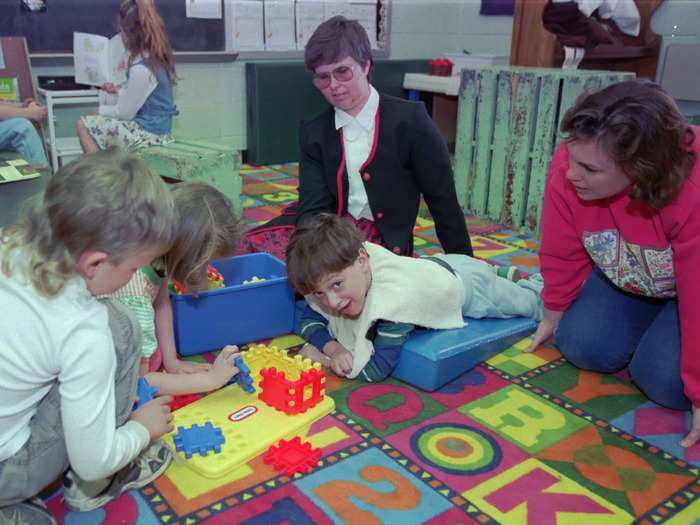
Eight-year-old Ricky Lattimer lay down on an alphabet mat in a kindergarten class at W.R. Croman Elementary School in Troy, Pennsylvania, accompanied by his support aide and physcal therapist. Seated at left is Sally Van Noy, learning support aide. Lattimer was one of the students with disabilities included in regular classrooms at the school.
1996: A student at J. Hayden Johnson Junior High School in Washington, DC, took notes during a single-sex class.
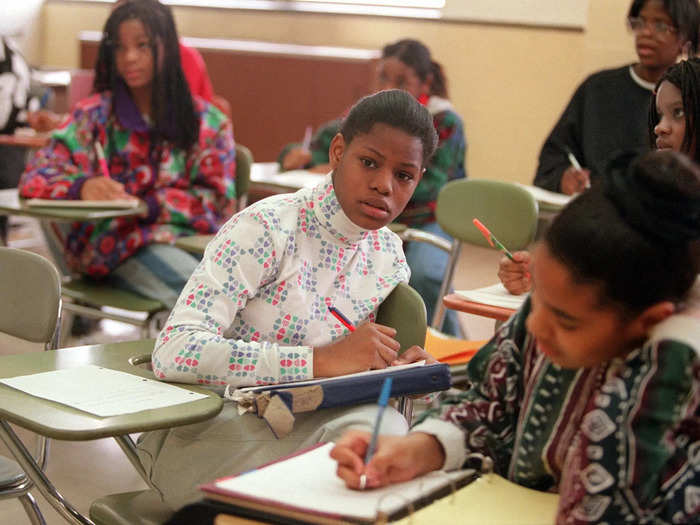
Single-sex schools have always existed, but teaching boys math, science and English separately from girls was new in public schools. More than a dozen states tested the concept.
1997: Vice President Al Gore talked to a group of elementary school students.
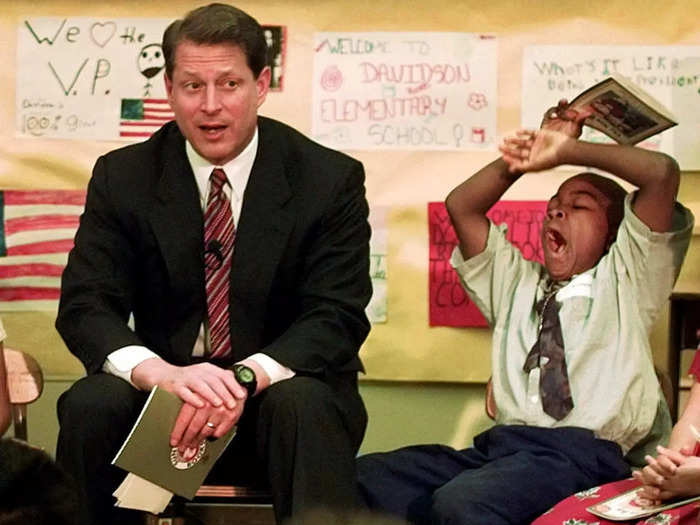
One student at Davidson Elementary School in San Bernardino, California, let out a yawn while Gore spoke.
1998: President Bill Clinton gave his weekly radio address from inside a trailer used as a classroom at Glenforest Elementary School in Falls Church, Virginia.
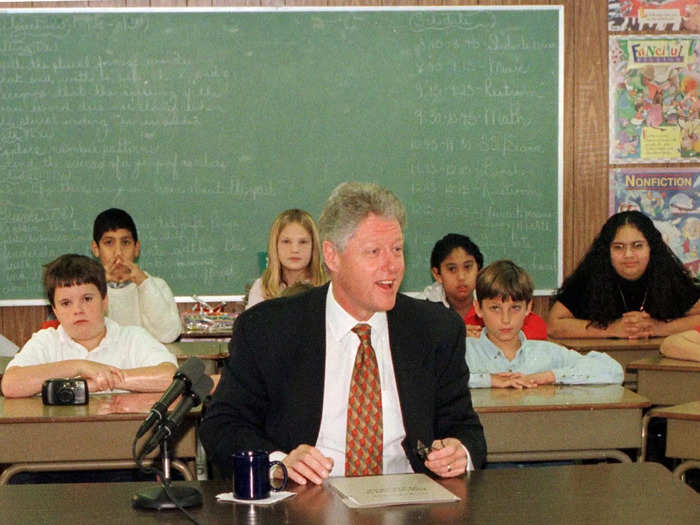
Clinton urged Americans to vote for candidates for Congress who will pass his school construction initiative that Republicans rejected.
1999: Students practiced their keyboarding skills at Richardson Independent School District's Forest Lane Academy in Dallas, Texas.
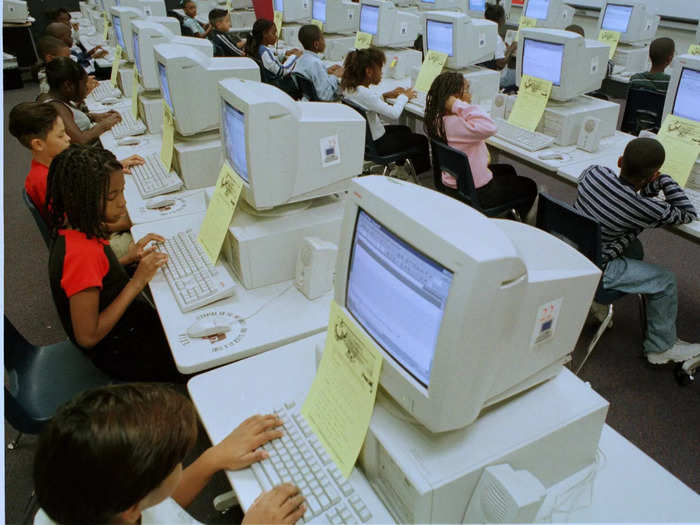
Houston's State Board of Education chairman suggested redirecting textbook funds into buying laptop computers and easily updated software.
2000: Virtual classrooms and online school gained popularity.
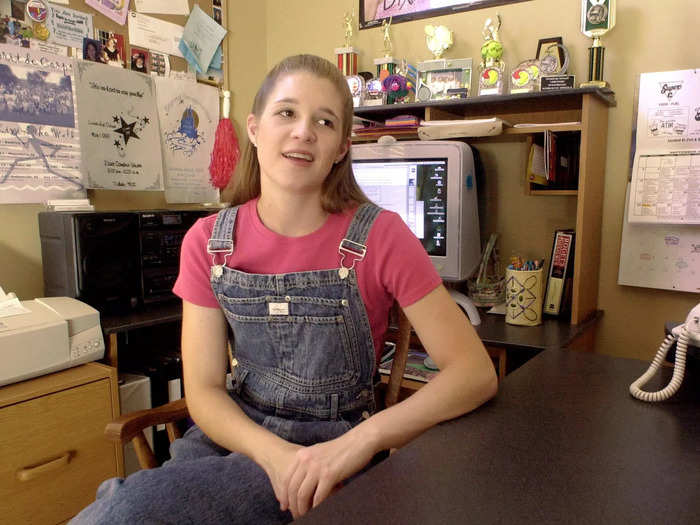
Sarah Dicke, a student at Lincoln High School in Lincoln, Nebraska, used a virtual classroom in which all the material for the class are online, and communicated with her teacher via email. She was one of a growing number of students turning to the internet to complete courses required for high school graduation or to get an early start on college.
2001: A boy ate his school lunch in Mason, Ohio.
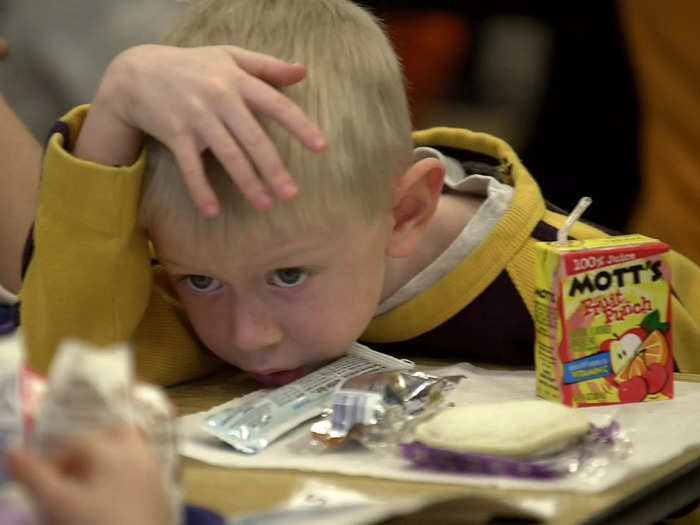
Mason Heights Elementary first grade student Gabe Richardson took a break from his lunch.
2002: Joanne Anthony used a whiteboard instead of the traditional chalkboard at the Southeast Academy of Scholastic Excellence in Washington, DC.
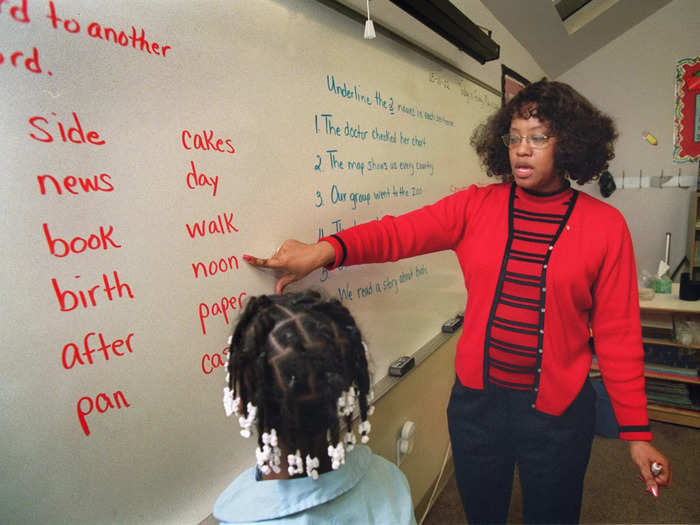
In the early 2000s, chalkboards were slowly being replaced by modern whiteboards that could also be utilized for virtual computer screens.
2003: Sixth-graders worked together on the computer in their English class in Kimberly, Idaho.
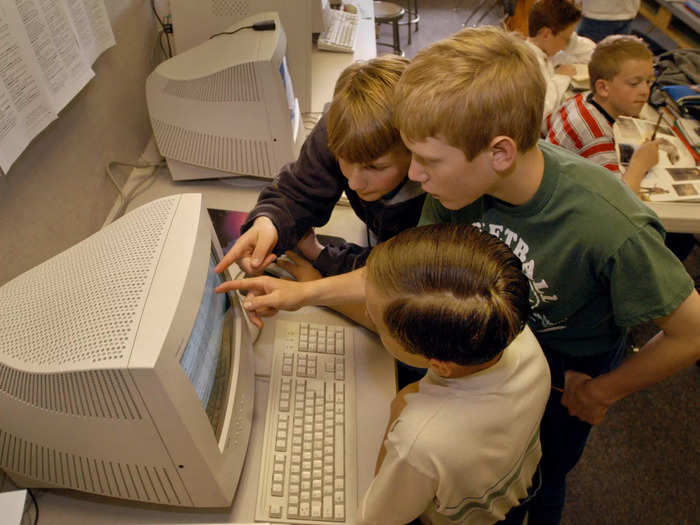
At Kimberly Middle School, the school's sixth-grade classes were divided up into separate classes, one for boys and one for girls, for the core classes of math, science, English, and social studies. Administrators said that there were less classroom problems as a result of the change.
2004: Senator James Jeffords read to students at the South Royalton Elementary School in South Royalton, Vermont.
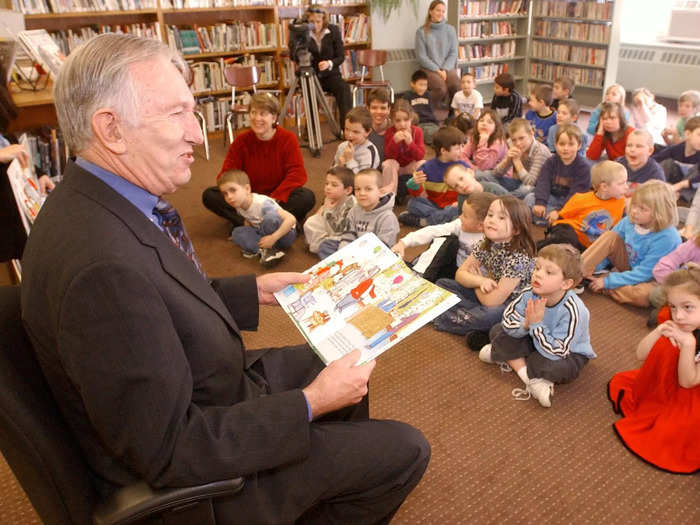
Jeffords visited the school in conjunction with an essay contest asking students what freedom means to them.
2005: A first grader read a book in a bilingual classroom.
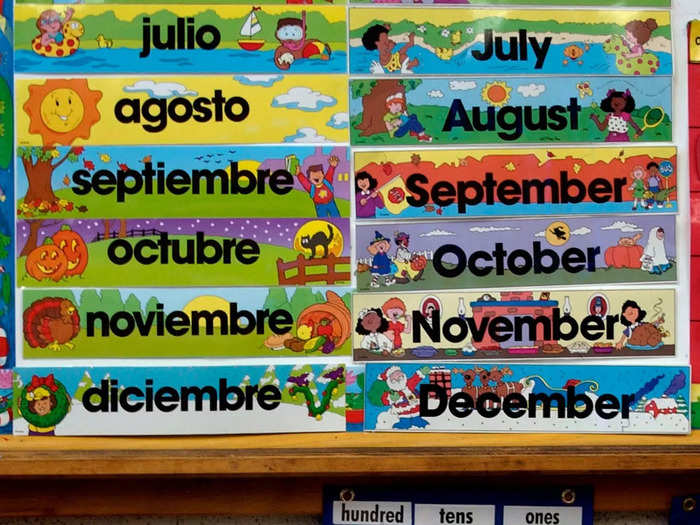
Kasandra Herrera, 6, read a book in Spanish in Bianca Alvarez's dual language first grade classroom at Northwest Elementary School in Dodge City, Kansas.
2006: Elton Hills Elementary School in Rochester, Minnesota, tried standing desks in an experimental classroom.
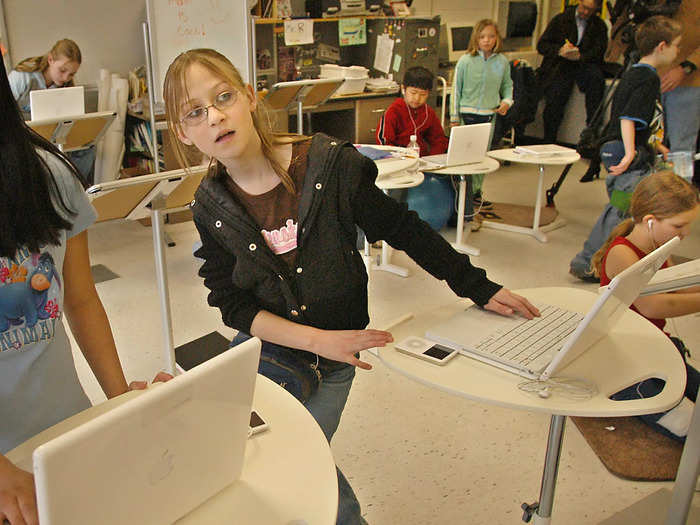
Obesity researchers from the Mayo Clinic wanted to learn whether classrooms really need desks, or if being able to move around helps students fight obesity while they learn.
2007: Language arts teachers told students not to use instant messaging slang in their writing.
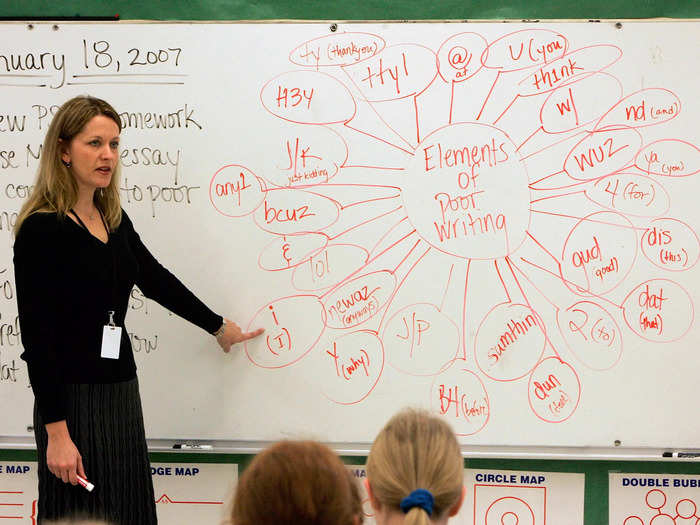
Language arts teacher Julia Austin instructed students against using instant messaging slang in their essays at Stonewall Jackson Middle School in Orlando, Florida.
2008: Students from the Louisa May Alcott Elementary School in Chicago, Illinois, watered herbs in the school's garden.
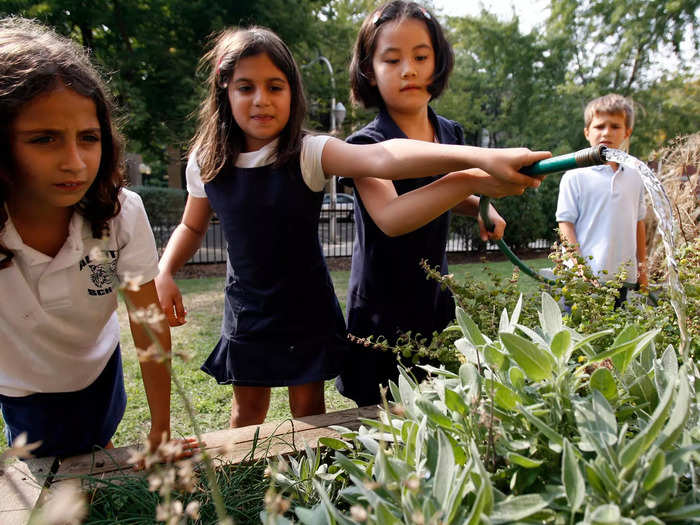
The garden, sponsored by the nonprofit Organic School Project, was part of a larger national movement to teach children healthy eating.
2009: Stability balls replaced chairs in a Colorado classroom.
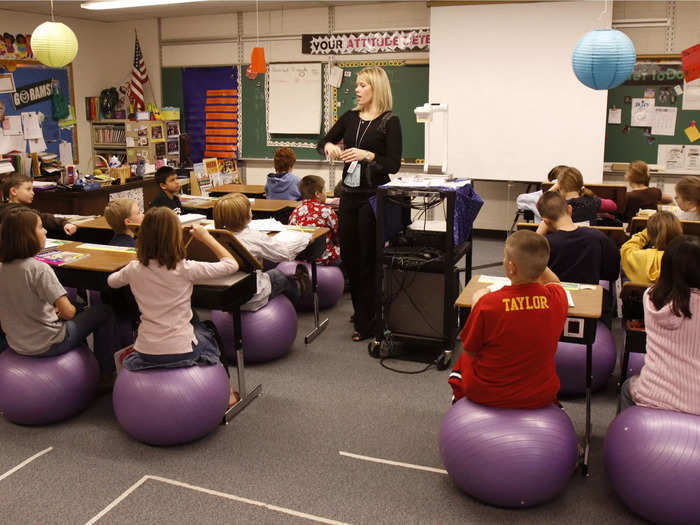
Tiffany Miller taught her fourth grade class at Bauder Elementary School in Fort Collins, Colorado, with exercise balls as chairs. A growing number of classrooms ditched the traditional classroom chairs in favor of stability balls as a way to improve student posture and attention.
2010: Students at the Sharon Elementary School in Sharon, Vermont, learned about nutrition.
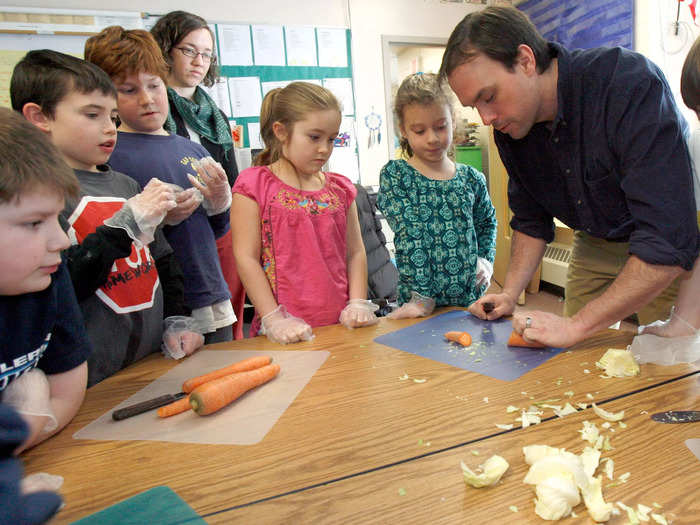
Teacher Keenan Haley teaches a curriculum about nutrition and agriculture.
2011: Students at the Bertschi School in Seattle, Washington, collected rainwater in their science classroom.
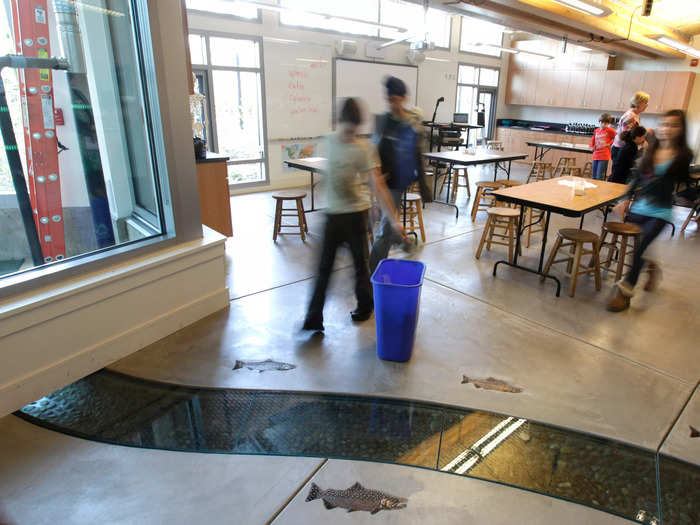
A glass-topped channel allowed collected rainwater to flow through their classroom in the school's new science building. The building was one of several dozen nationwide that recycles and manages rainwater and waste water on site.
2012: As Facebook grew in popularity, students began adding their teachers as friends.

Nkomo Morris, a teacher at Brooklyn's Art and Media High School who taught English and journalism, said she had about 50 current and former students as Facebook friends.
2013: Junie, a therapy dog at Prospect High School in Illinois, sat in a classroom.
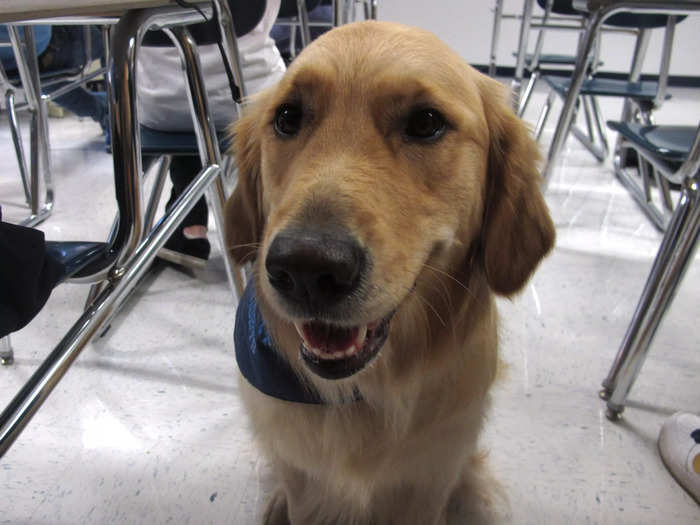
The 18-month-old golden retriever was one way this school tried to help students cope with a rise in stress, anxiety, and panic attacks.
2014: President Barack Obama recorded seventh graders at Buck Lodge Middle School in Adelphi, Maryland, on a classroom iPad.
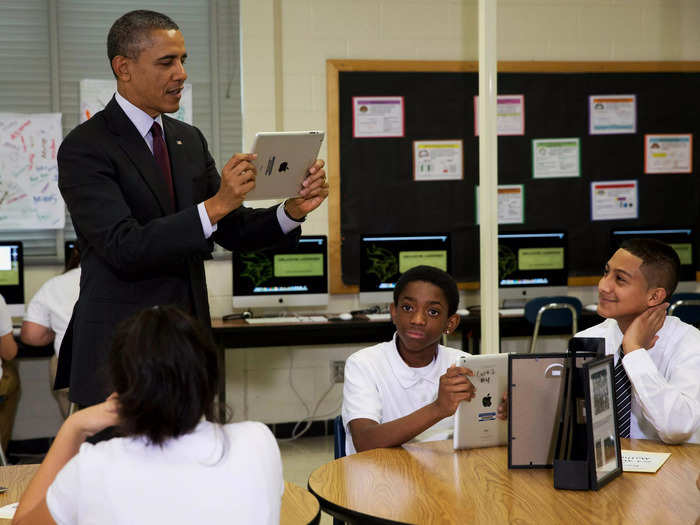
Obama spoke to the students about his goals of connecting students to next generation broadband and wireless technology.
2015: Students ate breakfast at the Stanley Mosk Elementary School in Los Angeles, California.
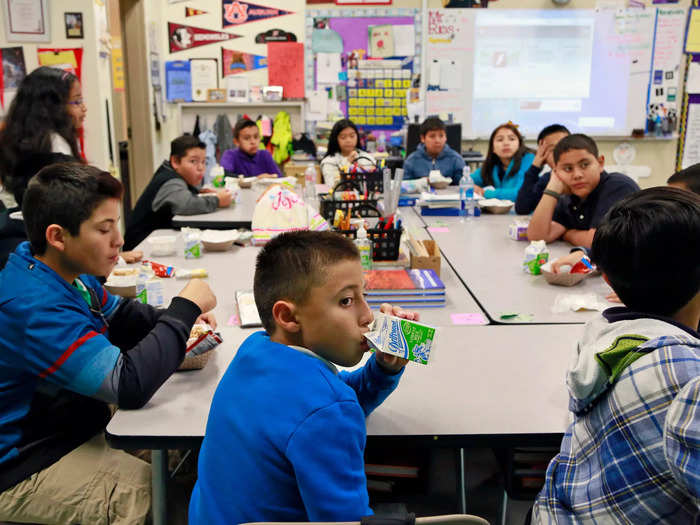
The number of breakfasts served in the nation's schools doubled in the last two decades, a surge driven largely by a change in how districts deliver the food. Instead of providing low-income students free or reduced-price meals in the cafeteria, they're increasingly serving all children in the classroom.
2016: Teacher Shannon Raftery used crowdfunding to pay for classroom supplies.
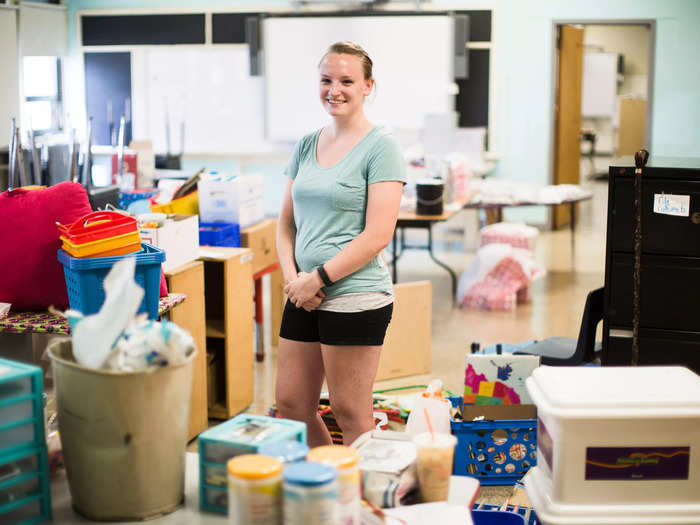
Raftery posed for a photograph in her classroom as she prepared it for the upcoming school year in Philadelphia, Pennsylvania. Raftery raised funds through crowdfunding to supplement the money she took out of each paycheck to pay for classroom supplies.
2017: Kindergarten teacher Susan Cody of the Northwest Primary School in Rutland, Vermont, showed Syrian refugee Dania Khatib, 5, around a classroom.
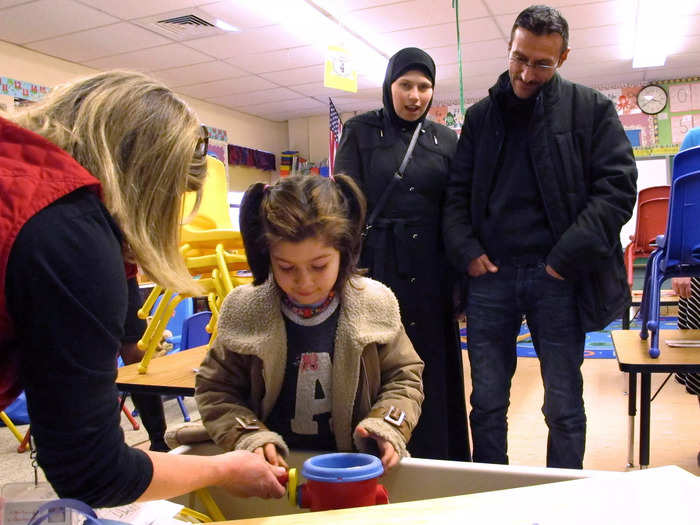
Dania's parents fled Syria in 2012 and the family lived in Turkey before arriving in Rutland.
2018: Students at Marjory Stoneman Douglas High School held a walkout to protest gun violence.
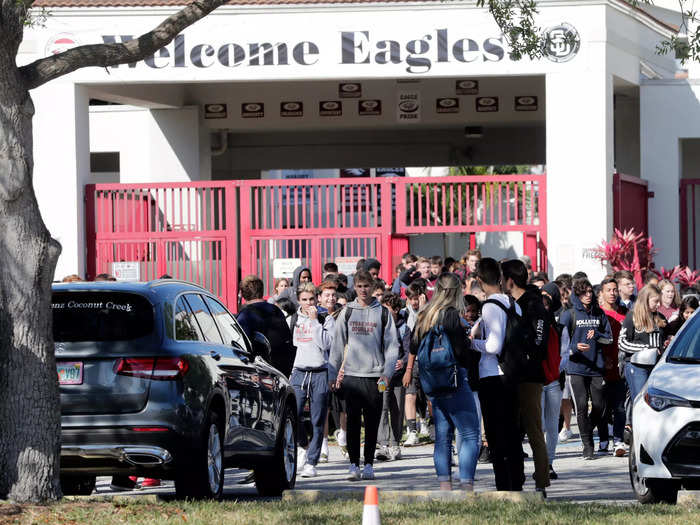
Following the massacre of 17 people at Marjory Stoneman Douglas High School in Parkland, Florida, in February 2018, students walked out as part of a nationwide protest against gun violence.
2019: Student activism around gun violence continued.
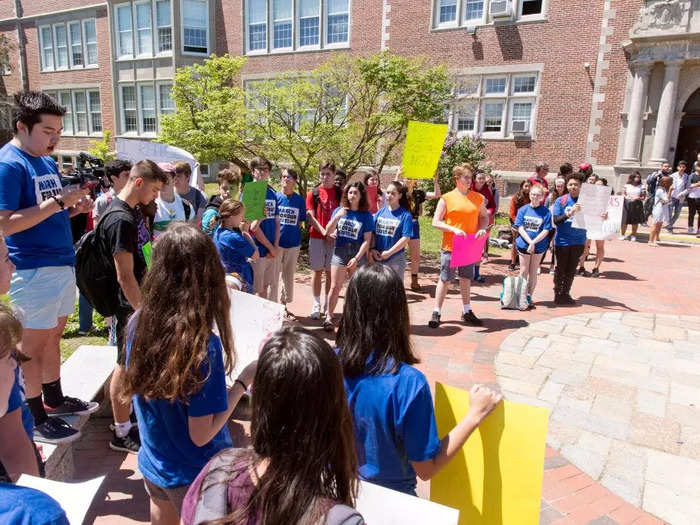
Conrad Nguyen, 17, stood on top of a bench outside of his school and spoke at a rally, organized by the local March For Our Lives chapter, in support of more gun control regulation.
2020: Schools pivoted to remote learning as the COVID-19 pandemic began.
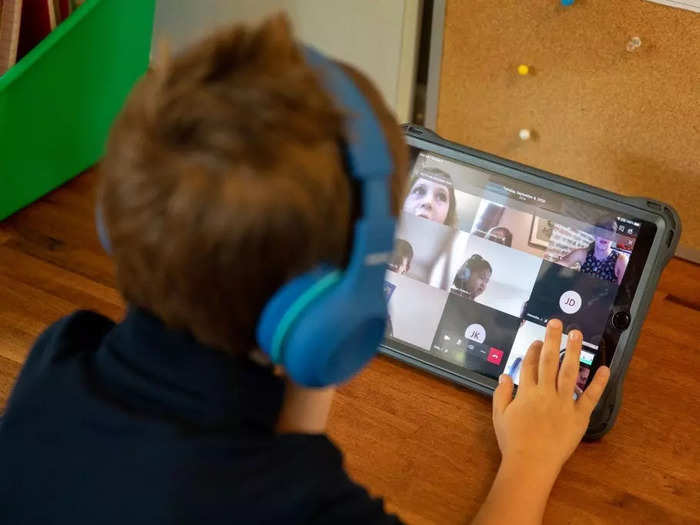
Jay Horton, 6, prepared for virtual first grade on the first day of school from his family's home in Arlington, Virginia.
2021: Some students returned to the classroom with hybrid learning.
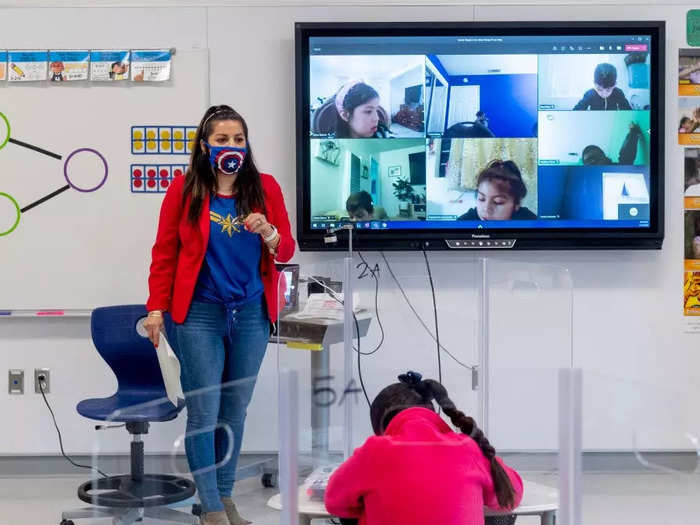
Teacher Maribel Reyes had some students in the classroom and some online at Sunkist Elementary School in Anaheim, California.
2022: School boards discussed banning critical race theory.
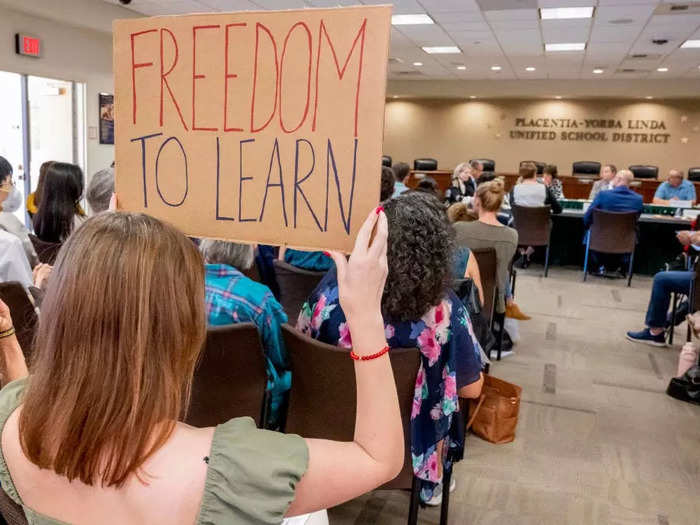
A student held up a sign reading "Freedom to learn" as members of the Placentia-Yorba Linda Unified School Board met to consider banning the academic concept of critical race theory in the district.
Popular Right Now
Popular Keywords
Advertisement